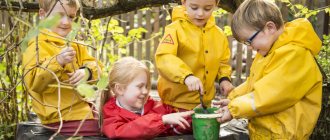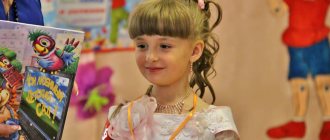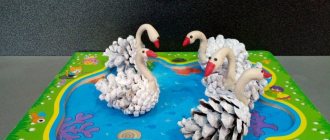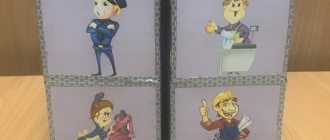NEW STRUCTURE – THIS IS MY MOTHER
- Place the “My family” cards on the table. Explain to the children that you will be talking about your family and will be showing the person you are talking about.
- Point to the first picture and say: This is my mother. Rearrange. Ask the children to repeat the sentence in chorus.
- Then say: My mother's name is Lena. Ask the children to guess the meaning of what was said and translate the sentences. Repeat the sentence in unison.
- Similarly, work out the sentences based on the pictures that remain.
game walker - my family. We roll the dice and walk. Let's call the little man. The teacher asks - who is this? -This is—
Lesson summary “My Family”
Summary of the lesson of the deputy director for educational work of the MBOUDOD Center for Children's Creativity in Aznakaevo
Aminova Ruzalia Mirzayanovna
FULL NAME. teacher
: Aminova Ruzalia Mirzayanovna
parole
: municipal budgetary educational institution for additional education of children Center for Children's Creativity in Aznakaevo, Aznakaevo municipal district of the Republic of Tatarstan
Program
: English for preschoolers “I can sing”
Lesson topic
: Here is my family (Family members)
Type of activity
: Classes on maintaining a new topic
Goals and objectives of the lesson:
Lesson objectives:
- introduction of vocabulary on the topic “My family”
- development of the skill of monologue statement on the topic “About myself”
Tasks:
Educational
:
— formation and consolidation of students’ primary knowledge on the topic “My family”
Educational:
— development of students’ imagination based on knowledge of the vocabulary of a new topic in their native language;
- develop attention, perseverance, memory.
Educational:
— developing interest in a foreign language.
Lesson form
: group
Methods
: verbal (story, explanation), visual (showing students illustrative aids: paintings), practical (exercises to consolidate vocabulary), reproductive (repeat after the teacher), control and correction (clarification of answers, correction of answers), game.
Didactic tools:
toys, pictures by topic
TSO
: record player
References
: V.N. Meshcheryakova. I can sing in English. Kazan. 2003.; English lessons by I.A. Murzinova. (https://www.englishhobby.ru).
- Organizational stage.
1.Goal for students:
Our guest forgot your names, got everything mixed up. Let's help him by answering “Yes, I am” (if he guesses your name) and “No, I am not” (if he doesn’t guess)
2. Goal for the teacher
: updating students’ basic knowledge on the topic “About yourself. My name is…..”, mobilizing their attention, introducing them to the sounds “a”, “ai”, “r”.
3. Criteria
: active involvement of students in the lesson process, participation in answering questions from all students, a sufficient number of correct answers.
Teacher:
Hello kids! I am so glad to see you! Let's begin our lesson! Let's sing a song! (Let's start our lesson and sing a song)
Good morning! Good morning! Good morning to you!
Good morning! Good morning! I am fine! How are you?
Oh, but where is Spot? (Where is Spot? We can’t start without him. (Spot is a toy that is one of the leaders of the lesson and is present in almost all lessons.) I remembered Spot told me this morning that to invite him, we need to count to five: So.
Children
: One, two, three, four, five (at this time the teacher takes out a toy)
Spot
: Hello kids!
D
: Hello Spot!
Spot
: Glad to see you!
U:
Spot, have you forgotten the guys' names? Let's check it now.
(Spot approaches the children and first says their names incorrectly, then...remembers):
Spot
: Are you Sveta?
(Spot approaches each student and asks the same question, and the students answer - Yes, I am or No, I am not. Thus, through repeated repetition of these two structures, children remember what this question means and how to respond to it) .
U:
Well done! Everyone answered Spot's questions correctly, you all know your names. Let's clap our hands. Clap your hands!
(Children clap their hands)
U:
Guys, funny people Englishsounds are here again. Quiet! Do you hear the sound? This little man breathes on the window glass (x....x.....x.....x) and draws letters with his finger. That’s what they called him (x), his name is just a light exhalation. Can you imagine how difficult it is with a name like that? Everyone is called to eat cake, but this little man doesn’t hear. Let's all call him together, maybe then he will hear us. The next Englishsound is afraid of everything. A door creaks or a dog barks, a little man screams (Ouch). Say after me ai…ai…ai…ai. And this Englishsound loves to scare everyone. He growls like a bear in the forest (g...g...g...g...g).
- Learning new material.
1. Purpose for students
: Today we will have another guest. He has been asking us for a long time and he says that he wants to introduce us to his... . With whom, you will find out later and I think you can tell me later.
2.Goal for the teacher
: introducing students to new words on the topic “Family”, developing students’ interest and creative imagination.
3 .
Lesson
stage 2 plan : 1. Look at the toys! What is this? (Toys). 2. The appearance of a guest. 3. Introduction of the guest's family members. 4 . Game “What is there in the bag?” 5. Learning the song “Do you have a father?…..”
4. Forms and methods of presentation
: working with toys, singing songs with grammatical structures, voicing dialogue with a guest, playing with new vocabulary.
5. Forms and methods of organizing student activities:
students, remembering previously studied words, first guess which guest will come, then get to know him, answering him and asking questions themselves, and in the end, relying on pictures without translation, they guess, learn about new words on the topic “My family” and through games and songs, i.e. through repeated repetition, they remember them in order to reproduce them without problems in the next lessons (mentally remembering how they were presented to them, the students)
6. Criteria for determining the level of attention and interest
: the lesson goes briskly, quickly, there are a lot of successive actions, the teacher is a real artist, he has to be both the teacher, the hero of the lesson and the guest at the same time, at the same time use all the methods, ways to speak English without translation and the most the main thing is that the students understand it.
- Look at the toys! What is this? Let's remember our toys. Another guest will come to us, maybe it’s someone we already know.
(The teacher shows the toys and asks everyone the same question What is this?, thus, this grammatical structure is consolidated through listening. The song “This is a bear”
- (there's a knock on the door) Look! Someone is knocking at the door! Who is it? ... It is me. Who are you? …. That is a secret! Guess! (a guest came, doesn’t say his name, asks the children to guess)
U: Are you a bear? Are you a dog?... (they ask questions using all the toys they know) Are you a boy? – Yes, I am. (to these words, the guest comes in, asks the guys How are you? And says that he brought his family album with him and wants to introduce the guys to his family members. The guest shows pictures and says: This is my father. This is my mother. This is my sister. This is my brother.
U: Let's repeat after him! - This is my father. This is my mother. This is my sister. This is my brother.
T: The teacher takes out a box and asks you to guess whose photograph is there.
- Learning the song “Do you have a father?”
Physical education minute
: Did you remember to do your exercises today? Now I’ll check: Stand up! Sit down! Hands up! Hands down! Hands on knees! Clap your hands! Stamp your feet! 1-2-3-Hop! 1-2-3- Stop!
- Consolidating new material
.
- Goal for students
: I think you have memorized new words. Now I propose to play a game with you and see who has the best memory.
- Goal for the teacher
: consolidation of new vocabulary, control and assessment of their level of attention, memory, identification of students’ attitude to the lesson.
- Forms and methods of fixing material
: game “Who is missing” (Who is missing? The teacher lays out photographs of the guest’s family members, the children look carefully, turn away, the teacher removes one of the photographs, the students determine which family member’s photo is missing and speak English), assessing the lesson with cards (red - very good, blue – bad).
- Mastery criteria:
the maximum number of students who name new words during the game in English, the ability to correctly evaluate their participation in the lesson and analyze the lesson (even if using a simple method: show cards)
4. Homework assignment
: You did great today! Today we managed to do a lot, sang songs and learned new words. Go to your parents and tell them what we did today.
Phonetic exercise (practicing sounds [ð]-[θ])
Today I want to tell you a fairy tale about two bees: English and Russian. One day a Russian bee was sitting on a flower. An English woman wanted to sit on the same flower. The Russian did not give up her place, and she began to swear: s-z-z-z-z! The little bee from England is not inferior to her and also swears. Her tongue is long and does not fit in her mouth. Like this: th-th-th-th-th! How did the Russian bee buzz? - z-z-z-z-z. - What about English? - th-th-th-th (3-4 times).
Russian says - [za-za-za], and English - (children repeat after the teacher) [ða-ða-ða]. Russian is [ze-ze-ze], and English is [ðe-ðe-ðe]. Russian is [zi-zi-zi], and English is [ði-ði-ði].
They swore like this all day, and by the evening they were tired, their voices were hoarse, but they still continued to argue: Russian - [sa-sa-sa], and English - [θа-θа-θа]. Russian is [si-si-si], and English is [θi-θi-θi].
How to make the Family theme not only understandable, but also loved by your child?
Hello my dear.
Did you know that in Chinese, maternal grandmother and paternal grandmother are two different words and two completely different sets of characters? It’s good that in English everything is much simpler regarding family! Although, knowing from experience, the topic of family in English for children turns out to be some kind of incredible problem.
Want to make this process a lot easier? Today I will help you with this! We will get acquainted with vocabulary on the topic “family”, a couple of stories in English, as well as interesting ways to make studying this topic much easier.
Distant relatives
In addition to grandparents, there are other relatives.
- Relatives - relatives (applies to all relatives).
Aunt ['ɑ:nt] [a:nt] - aunt, uncle ['ʌŋkl] [ankl] - uncle. Their children are designated by the word cousin. Cousin ['kʌzn] [treasury] is translated in two ways: cousin/cousin. It can be used in the plural. Bob is my cousin . Lena and Kate are my cousins .
In Russian we call the children of our brother or sister “nephew” or “niece”. In English it sounds nephew ['nevju:] [newu] - nephew, niece ['ni:s] [ni:s] - niece.
Godparents and godchildren:
- Godfather - godfather [ˈgɒdfɑːðə] [godphase]
- Godmother - godmother [ˈgɒdmʌðə] [godmaze]
- Godson - godson [ˈgɒdsʌn] [godsan]
- Goddaughter - goddaughter [ˈgɔddɔːtə] [goddo:te]
Another group of words:
When we describe relatives of a husband or wife, we add - in law , [in lɔ:] [in lo:], which literally translates “in law” or “according to the law.”
- Brother in law - brother of husband, wife. Notice how much easier it is than in Russian. Since in Russian it is called brother-in-law and brother-in-law.
- Sister in law - sister of a husband or wife. In Russian there are names for them - sister-in-law and sister-in-law.
- Mother in law - mother of a husband or wife, in Russian mother-in-law and mother-in-law.
- Father in law - father of a husband or wife, in Russian father-in-law or father-in-law.
- Son in law - son-in-law.
- Daughter in law - daughter-in-law.
If we want to say that he or she is married, we use the expression to be married [tuː biː ˈmærɪd] [tu bi marid]: My brother is married . — My brother is married . Her sister is married . — Her sister is married .
Saying that he/she is divorced, we use the expression to be divorced [tuː biː dɪˈvɔːst] [tu bi marvel:st]: My aunt is divorced . — My aunt is divorced .
Another word that may be useful to you is bachelor [ˈbæʧələ] [bechele] - bachelor: My cousin is a bachelor . — My cousin is a bachelor .
If we want to say that a woman is not married, we must say: She is unmarried .
If a girl and a guy meet, we talk about them: boyfriend/girlfriend.
Young people who are going to get married:
- fiance - [fi'ɑ:nsei] [fiansey] - groom
- fiancée - [fi'ɑ:nsei] [fiansey] - bride
'fee-yon-say' - similar to the name of the singer Biense. Americans pronounce these two words [fɪˈænsɪ] [fiency].
- His fiancée and he will be married in September. — His fiancee and he will get married in September.
In Russian, “bride and groom” sound the same before the wedding in the registry office and after during the wedding they are still “bride and groom”. In the English, after the moment of marriage, they are called differently: a bride [braɪd] [bride] - the bride (newlywed) and a bridegroom [ˈbraɪdgrum] [bridegroom] or simply a groom - the groom (newlywed).
This is interesting: In the UK there is a law - once every 4 years during a leap year, women are allowed to ask for the hand of the young man they like. This year, such an act is not considered something immoral and reprehensible. Previously, they did this using special postcards.
Let's start learning vocabulary
Children love their family. They do it with pleasure. This is the age when they easily remember information. But psychologists believe that the threshold for forgetting is 3 days. That is, you need to practice regularly in order to see results.
We work with kids using pictures, videos, and cartoons. First, show a picture, it could be a family photo, and voice the image. Let your child repeat after you several times. Due to their age, they still cannot read. In any case, first the picture, then the word.
Flashcards and workbook
We recommend dividing words from the topic “Family” into two lessons. If you have the opportunity, print out cards and workbooks, you can work with them in any way, the more fun and dynamic, the better






